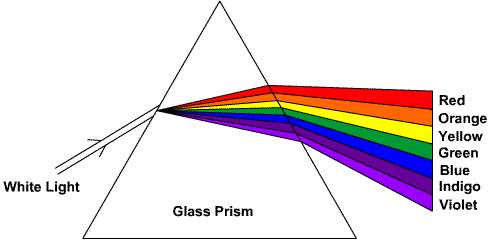|
The speed of light is slower in various
materials than it is in a vacuum or outer space. When
the light passes into a material at an angle, the light
beam is bent or refracted according to Snell's Law and
the index of refraction of the material. But also, the
speed of light through a material varies slightly with
the wavelength or frequency of the light. Thus, each
wavelength is refracted at a slightly different angle
when passing through a material at an angle. This
spreading out of the beam of light is called dispersion
or chromatic dispersion. This can be seen when sunlight
passes through a glass prism. Dispersion can cause
problems with camera lenses and must be minimized.
Questions you may have include:
Index and wavelength
The velocity of light in a material--and
thus its index of refraction--depends on the wavelength
of the light. In general, the index of refraction is
greater for shorter wavelengths. This causes light
inside materials to be refracted by different amounts
according to the wavelength or color.
The wavelength of visible light is very
short and often measured in nanometers (nm), which are 1
billionth of a meter (10-9 meter).
|
Blue |
434 nm |
1.528 |
|
Yellow |
550 nm |
1.517 |
|
Red |
700 nm |
1.510 |
Comparison of wavelength and Index of
Refraction
Note: In general shorter wavelengths
(i.e. light towards the blue end of the spectrum) have
higher indices of refraction and get bent more than
light with longer wavelengths (towards the red end).
Spectrum from prism
Sunlight is often called white light,
since it is a combination of all the visible colors.
Since the index of refraction is different for each
color, the angle of refraction will be different for
each color when the light passes from air into glass or
other transparent material. This is according to Snell's
Law. (See Snell's Law for the Refraction of Light for
more information.)
Now if the piece of glass has parallel
sides--such as with a window--the light will return in
the same direction that it entered the material. But if
the material is shaped like a prism, the angles for each
color will be exaggerated, and the colors will be
displayed as a spectrum of light.

Prism spreading white light into a
spectrum of light
The visible colors are in the order of
the spectrum. You can remember the order by the name ROY
G. BIV. Note that in the illustration above, the colors
are distinctly separated. In realty, they blend into
each other, such that there are colors in between. For
example, there is red-orange in between red and orange.
Tiny droplets of water refract the white
light from the Sun and create a spectrum of colors
similar to what happens in a prism. Since the droplets
are spheres, the light is reflected internally in the
droplets and the spectrum or rainbow returns toward the
direction of the light. That is why the Sun will always
be behind you when you see a rainbow.
Camera lenses
Chromatic dispersion can be a problem in
optical equipment like cameras, microscopes and
telescopes. Since a lens is similar to a prism, it will
disperse the light into a spectrum. This can be
exaggerated when there are several lenses in the system.
But you don't want a blurry image where the system
focuses different colors of light at different spots.
Such blurring is called chromatic aberration.
The solution to that problem is to
combine a positive lens that has one index of refraction
with a negative lens of a different type of glass and a
different index of refraction, such that the dispersion
of the two negate each other.
The speed of light through a material
varies slightly with the wavelength or frequency of the
light. Each wavelength is refracted at a slightly
different angle when passing through a material at an
angle. This spreading out of the beam of light is called
dispersion. This can be seen in a rainbow or when
sunlight passes through a glass prism. Dispersion can
cause problems with camera lenses and must be minimized. |